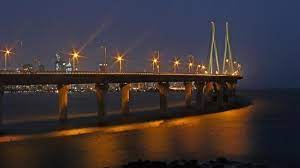- The Prime Minister will officially open the Mumbai Trans Harbour Link (MTHL), also known as the Atal Setu Nhava Sheva Sea Link.
- This 22-kilometer bridge, which was conceived six decades ago, is a key breakthrough in India’s infrastructure, promising to alter connectivity and economic possibilities in the Mumbai Metropolitan Region.
The Mumbai Trans Harbour Link Bridge is known as Atal Setu
- The MTHL is a 22-kilometer-long, six-lane twin-carriageway bridge that spans Thane Creek in the Arabian Sea. It links Mumbai’s Sewri to Raigad’s Chirle.
- The construction consists of a 16.5 km maritime connection and 5.5 km of land viaducts at both ends.
- The MTHL is projected to boost economic growth, cut travel time, and relieve congestion on current routes by improving connectivity within the Mumbai Metropolitan Region.
Historical Context and Evolution
- The notion of a bay crossing was initially presented by Wilbur Smith Associates in 1963, but it lay dormant for decades.
- Revival and Obstacles: The project was resurrected in the late 1990s, and the first bids were issued in 2006. Following Reliance Infrastructure’s initial involvement and later withdrawal, the project encountered a number of bidding hurdles.
- Funding and implementation: The Mumbai Metropolitan Region Development Authority (MMRDA) collaborated with the Japan International Cooperation Agency (JICA) to secure funds, allowing construction to begin in early 2018. The project cost Rs 21,200 crore in total, with a major financing from JICA.
Impact of the Mumbai Trans Harbour Link
- Travel Time Reduction: According to a study conducted by the MMRDA and JICA, the MTHL would reduce the average travel time between Sewri and Chirle from 61 minutes to less than 16 minutes.
- Economic and connectivity advantages: The bridge is planned to integrate Navi Mumbai’s economy with that of Mumbai and to increase access to vital areas like as the Navi Mumbai International Airport, the Mumbai Pune Motorway, and the Mumbai-Goa Highway.
- Vehicle Traffic: 40,000 cars are projected to utilise the route daily during its first year.
Concerns and Difficulties
- Commuter Accessibility: The bridge’s value for everyday travellers between Mumbai and Navi Mumbai remains in doubt, given the high toll cost and the distance of landing locations from major residential areas.
- Additional Transportation Costs: The toll rate of Rs 250 for a one-way passage, as well as the bridge’s landing sites being more than 10 km from major residential areas like Vashi and Nerul, may raise commuting costs.
- There are currently no announcements for public transit infrastructure, such as dedicated bus lanes, on the bridge.
Source: https://www.indiatoday.in/india/story/mumbai-trans-harbour-link-atal-setu-indias-longest-sea-bridge-to-be-inaugurated-by-pm-modi-2487661-2024-01-12#:~:text=ALL%20ABOUT%20THE%20MUMBAI%20TRANS,about%205.5%20km%20on%20land.

